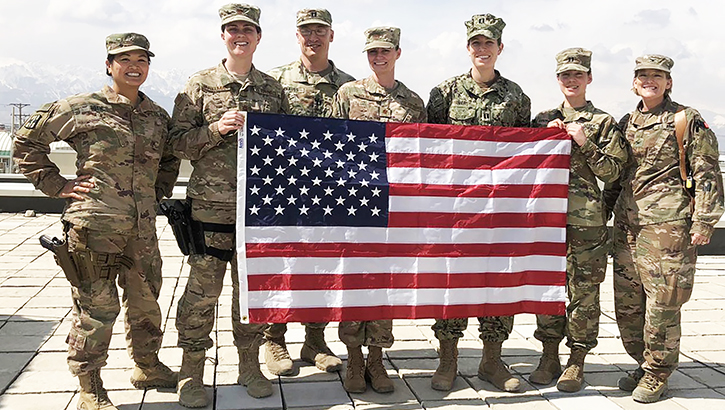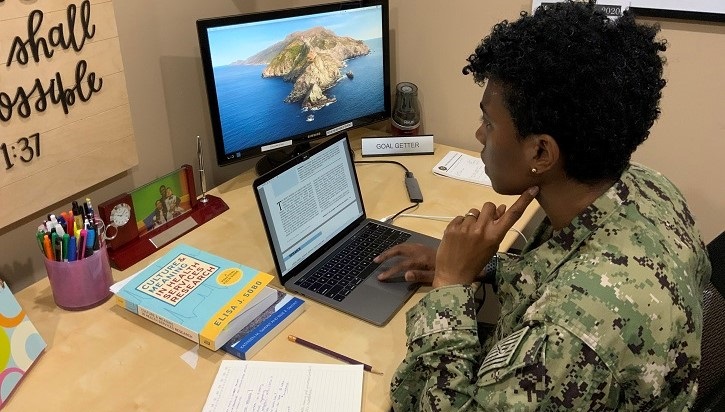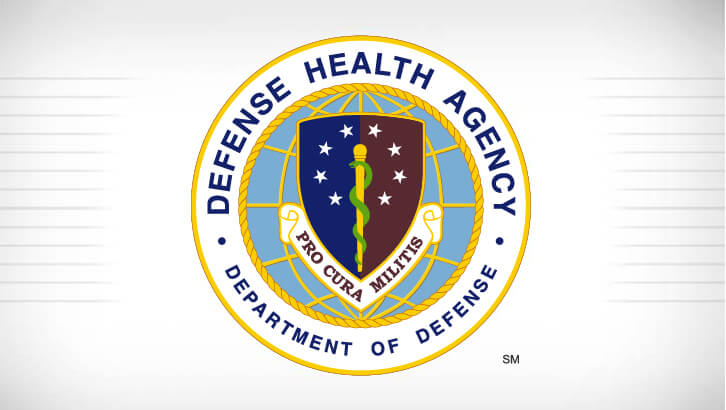
From the battlefield to the homefront: MHS nurses continue to serve

Army Col. Tammy Funari (far right) poses with other members of U.S. Central Command's multidisciplinary joint clinical operations team after a March 2019 site visit at a medical treatment facility in Afghanistan. (Photo courtesy of Col. Tammy Funari)
In peacetime and war, nurses in the Military Health System provide medical care around the globe to service members, retirees, and their families. It's a critically important function -- but it's not the only role for nurses. More than 100 years after nurses became a permanent part of the armed forces, their opportunities have greatly expanded. Nurses now fill important positions in administration, leadership, research, and education. And when a crisis like COVID-19 hits, nurses nimbly pivot to care for patients and maintain force readiness.
Approximately 28,000 women and men serve as nurses in the Military Health System across the globe. Those ranks include Army Col. Tammy Funari. She serves as the chief nurse, and chief of clinical operations, for U.S. Central Command or USCENTCOM at MacDill Air Force Base, Florida. Funari also serves as consultant to the Army Surgeon General for medical surgical nursing.
"The primary focus has been trauma, of course, because we've been deployed at war for going on 20 years now," Funari said. "But the operational tempo went up considerably for the Surgeon Directorate as soon as COVID-19 hit."
The threat of the highly contagious virus was of particular concern downrange, Funari said. "This could easily get brought into theater with all of the troop rotations. And what you already have, with supplies and personnel, is all you have to work with."
To meet the challenge, Funari pulled together chief nurses from the military treatment facilities, clinical operations chiefs, and the performance improvement team from the Joint Trauma System directorate. Together, they established an educational platform for vital skills needed to care for critically ill COVID-19 patients.
They also created, with deployed nurses and physicians, an operational playbook. It addresses COVID-19 concerns for U.S. forces in the USCENTCOM area of responsibility. The playbook answers many questions from the field. And it serves as a focal point that links the available resources including the newly published DoD clinical practice guidelines for COVID-19 care in austere environments. The playbook also describes methods to enhance the skills of the nurses and medics already downrange, and provides a one-stop shop for finding clinical support.
"My favorite role as a nurse is when I can coach and mentor junior health care professionals," Funari said.
Navy Lt. Berly Vincent also thrives in the educator role. He serves as a clinical nurse specialist in the medical oncology nursing unit at Walter Reed National Military Medical Center in Bethesda, Maryland.
Vincent has developed education and training programs on topics including blood products and tumor radiation therapies. When COVID-19 hit, Vincent and two other clinical nurse specialists developed a training plan to ensure staff at Walter Reed were trained to properly take care of COVID-19 patients. The plan also was shared with other MTFs.
"We've already formally trained over 1,000 nurses," Vincent said, with a combination of online education, hands-on training, and simulations.
Vincent says he was inspired to join the military by his older sister, who's also a Navy nurse.
"Ever since my freshman year in college, I knew this is what I wanted to do," he said. "I enjoy impacting the nursing role, the hospital, and patient care by implementing evidence-based best practices."
MHS nurses keep service members medically ready to deploy anywhere in the world. They also protect, promote, and improve health care in support of operational objectives.
U.S. Public Health Service Lt. Bobby Taylor helps care for MHS beneficiaries through his role as program manager for the MHS Nurse Advice Line. With physical distancing because of the COVID-19 pandemic, Taylor said the Nurse Advice Line is crucial to ensure the 9.5 million MHS beneficiaries get the care they need from registered nurses anytime, at no cost, without leaving the safety and comfort of home.
"It's rewarding work for me," Taylor said. "I'm helping make sure we provide the best avenues for treatment and care for callers."
Indeed, providing the best possible care is at the heart of every role nurses hold. Air Force Lt. Col. Jennifer Jamison-Gines is an acute care nurse practitioner consultant, and deputy director of critical care, at Keesler Air Force Base, Mississippi. Her career includes several deployments with critical care air transport teams. For five months in 2006, she cared for over 75 patients in 33 air evacuation missions in Afghanistan and Iraq.
"Of all the really cool stuff that I've been able to do, the most rewarding is the time I get to spend at the bedside," Jamison-Gines said. "It's a privilege to escort patients through this, to care for them and ease their suffering, and to be written into their family history."
Graduate Nursing Student Tells of Challenges to Pursuing Doctoral Degree during COVID-19
Article
5/12/2020

Although graduate work is done independently, much of it requires in-person collaboration and data collection.
US Coast Guard spouse volunteers at Maastricht hospital, saves lives
Article
5/12/2020

Working at the COVID-19 unit does come at a cost – a personal sacrifice that remains mostly unseen.
Ventilator Basics - Part 2 (ACPC and PS) (March 25, 2020)
Video
5/11/2020

This video is an introduction to pressure control and pressure support ventilator settings. If you have not yet viewed 'Vent Basics for Non-Intensivists (ACVC/VAC)", please watch that video first. This video is not intended to be all encompassing. It is intended to educate non-intensivists on basic vent settings and vent mechanics.
Sedation and Analgesia in the ICU during COVID-19 (March 31, 2020)
Video
5/11/2020

This video is intended to assist healthcare providers with the care of critically ill patients only. It is to be used as a guide ONLY for patients who have breathing tubes and are mechanically ventilated (on breathing machines). It will introduce you to sedative and analgesic medications that are used in the intensive care unit setting only. It will provide recommendations for use of sedation and analgesia in standard settings, but it will also provide recommendations for use in resource limited
IV Vasoactive Medication Basics for the Non Intensivist (March 19, 2020)
Video
5/11/2020

This video provides a refresher/introduction to the basics of inotropes and vasopressors that may be helpful in the context of treating COVID-19 patients. It is not intended to be all-encompassing.
Airway Pressure Release Ventilation (APRV) (April 17, 2020)
Video
5/11/2020

This video will explain the basics of Airway Pressure Release Ventilation, an option for mechanical ventilation, that is helpful as an oxygen salvage therapy for patients with Acute Respiratory Distress Syndrome (ARDS).
Multi-Dimensional Approach To Intubation In The Setting Of COVID-19 (April 1, 2020)
Video
5/11/2020

In this video, a doctor and nurse will talk you through preparing to intubate a patient. At the end of the video we highlight some special considerations for intubation in the context of COVID.
Acute Respiratory Distress Syndrome Lecture (April 10, 2020)
Video
5/11/2020

In this lecture, the topic or Acute Respiratory Distress Syndrome is reviewed. Specific discussion on diagnosis and treatment including lung protective strategies are discussed.
Transport Vent Tutorial (ParaPAC) (March 25, 2020)
Video
5/11/2020

Transport Vent Tutorial - ParaPAC
Ventilator Basics (ACVC) (March 19, 2020)
Video
5/11/2020

Ventilator basics (one mode) for non-intensivists
Shock Basics for the Non-Intensivist (March 19, 2020)
Video
5/11/2020

Shock Basics for the Non-Intensivist...in the age of COVID-19.
ICU Nursing Series: Assembling Pressure Tubing (March 31, 2020)
Video
5/11/2020

This video will review how to assemble pressure tubing to transduce pressures and waveforms from arterial lines and central lines. Connection to an ICU monitor with zeroing is also reviewed.
Awakening Trials, Breathing Trials, and Extubation (March 27, 2020)
Video
5/11/2020

This video covers safety screens and failure criteria for Spontaneous Awakening Trials (SATs) and Spontaneous Breathing Trials (SBTs). These together form the ABCs of daily care of ICU patients on vents (Airway and Breathing Coordination). Additionally, it covers the criteria that should be met prior to attempting extubation.
Ventilator Tutorial V500/PB840 Drager (April 10, 2020)
Video
5/11/2020

Ventilator assembly and input of settings for two common ICU ventilators.
Sepsis In The Age of COVID-19 (April 10, 2020)
Video
5/11/2020

This video will review diagnosis and management of sepsis with some clarifications/alterations that apply during the COVID pandemic. This video is not all inclusive. It is meant as a refresher for non-intensivists.






















.png)











No hay comentarios:
Publicar un comentario